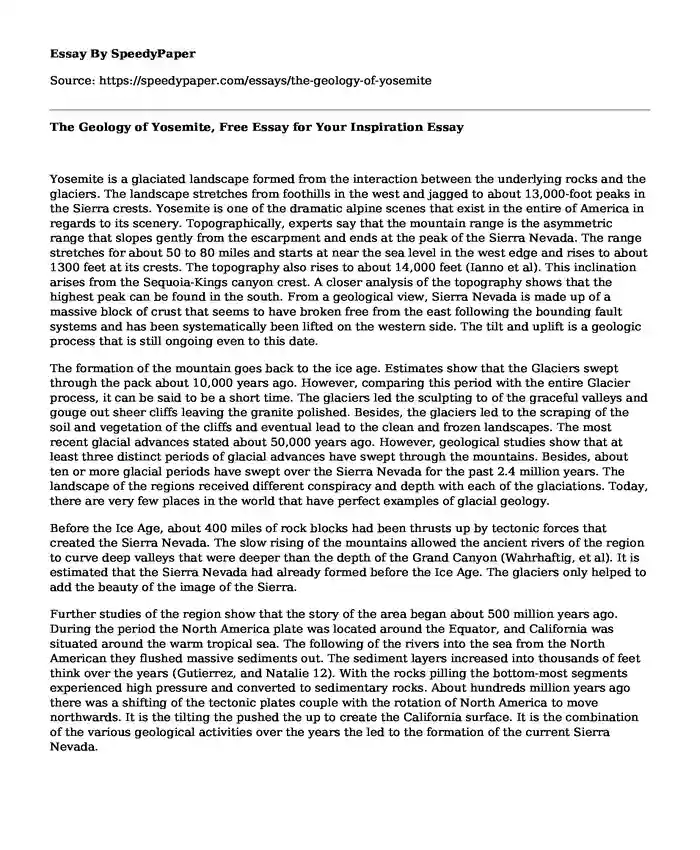Yosemite is a glaciated landscape formed from the interaction between the underlying rocks and the glaciers. The landscape stretches from foothills in the west and jagged to about 13,000-foot peaks in the Sierra crests. Yosemite is one of the dramatic alpine scenes that exist in the entire of America in regards to its scenery. Topographically, experts say that the mountain range is the asymmetric range that slopes gently from the escarpment and ends at the peak of the Sierra Nevada. The range stretches for about 50 to 80 miles and starts at near the sea level in the west edge and rises to about 1300 feet at its crests. The topography also rises to about 14,000 feet (Ianno et al). This inclination arises from the Sequoia-Kings canyon crest. A closer analysis of the topography shows that the highest peak can be found in the south. From a geological view, Sierra Nevada is made up of a massive block of crust that seems to have broken free from the east following the bounding fault systems and has been systematically been lifted on the western side. The tilt and uplift is a geologic process that is still ongoing even to this date.
The formation of the mountain goes back to the ice age. Estimates show that the Glaciers swept through the pack about 10,000 years ago. However, comparing this period with the entire Glacier process, it can be said to be a short time. The glaciers led the sculpting to of the graceful valleys and gouge out sheer cliffs leaving the granite polished. Besides, the glaciers led to the scraping of the soil and vegetation of the cliffs and eventual lead to the clean and frozen landscapes. The most recent glacial advances stated about 50,000 years ago. However, geological studies show that at least three distinct periods of glacial advances have swept through the mountains. Besides, about ten or more glacial periods have swept over the Sierra Nevada for the past 2.4 million years. The landscape of the regions received different conspiracy and depth with each of the glaciations. Today, there are very few places in the world that have perfect examples of glacial geology.
Before the Ice Age, about 400 miles of rock blocks had been thrusts up by tectonic forces that created the Sierra Nevada. The slow rising of the mountains allowed the ancient rivers of the region to curve deep valleys that were deeper than the depth of the Grand Canyon (Wahrhaftig, et al). It is estimated that the Sierra Nevada had already formed before the Ice Age. The glaciers only helped to add the beauty of the image of the Sierra.
Further studies of the region show that the story of the area began about 500 million years ago. During the period the North America plate was located around the Equator, and California was situated around the warm tropical sea. The following of the rivers into the sea from the North American they flushed massive sediments out. The sediment layers increased into thousands of feet think over the years (Gutierrez, and Natalie 12). With the rocks pilling the bottom-most segments experienced high pressure and converted to sedimentary rocks. About hundreds million years ago there was a shifting of the tectonic plates couple with the rotation of North America to move northwards. It is the tilting the pushed the up to create the California surface. It is the combination of the various geological activities over the years the led to the formation of the current Sierra Nevada.
Works Cited
Gutierrez, Joseph A., and Natalie Bursztyn. "The Story of Ice: Design of a Virtual and Augmented Reality Field Trip Through Yosemite National Park." Cases on Smart Learning Environments. IGI Global, 2019. 1-16.
Ianno, Adam J., et al. "Appendix 2: Geologic mapping of the metasedimentary May Lake Pendant, Yosemite National Park, California." studies of the late cretaceous magmatic crustal column at Joshua tree national park, California (2018): 293.
Wahrhaftig, Clyde, et al. Extent of the Last Glacial Maximum (Tioga) Glaciation in Yosemite National Park and Vicinity, California. No. 3414. US Geological Survey, 2019.
Cite this page
The Geology of Yosemite, Free Essay for Your Inspiration. (2022, Feb 24). Retrieved from https://speedypaper.net/essays/the-geology-of-yosemite
Request Removal
If you are the original author of this essay and no longer wish to have it published on the SpeedyPaper website, please click below to request its removal:
- Free Essay Sample on Physical Therapist Requirements
- Essay Sample on Legal Issues in Criminal Courts
- The Mandala Tree of Life - Free Essay Example
- Don't Privatize Air Traffic Control, Essay Sample
- Religion Essay Sample: Islam in Africa
- Zero Tolerance: America's Failed Solution to Gun Violence in Schools
- Essay Sample on Areas of Strength Within the Leadership Domain
Popular categories





